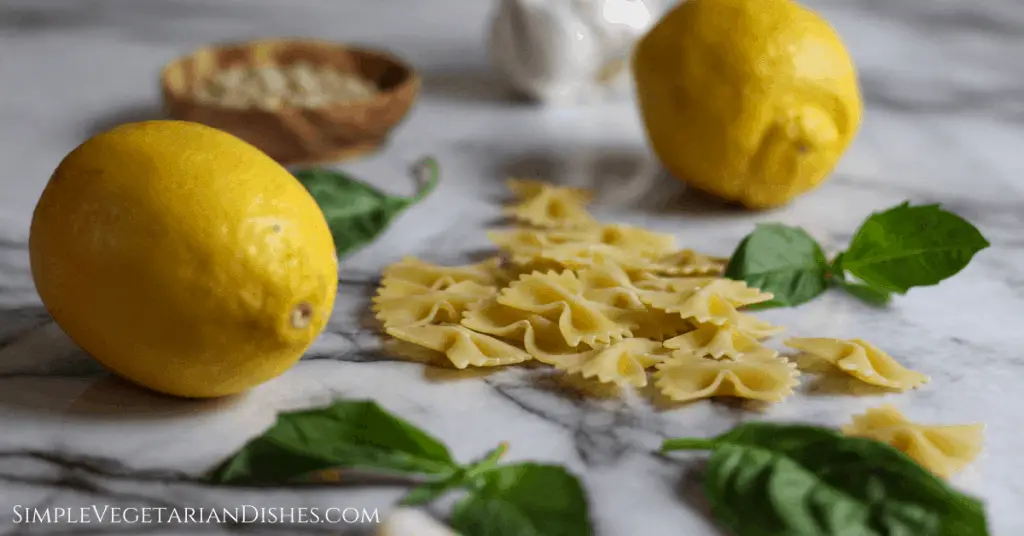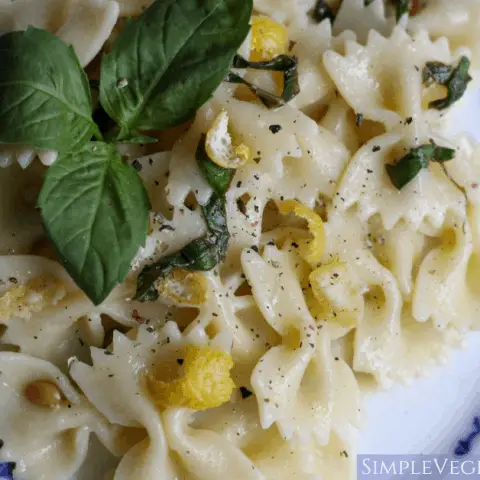This bright lemon pepper pasta is a simple way to bring some sunshine onto your plate!

Depending on the size of your family, this large batch will provide you with a nice supply of tasty leftovers, too.
It’s a quite simple yet satisfying dish of pasta with toasted pine nuts, lemon zest, garlic, and fresh basil with a lemon juice and olive oil sauce.
You may also enjoy my vegan garlic bread to accompany this dish, or for faster results, my frozen garlic bread in the air fryer.
This recipe calls for using some of the pasta water leftover from cooking the pasta in the sauce, so you will want it to be pleasantly salty. I used about a tablespoon of salt.
Why do you use pasta water?
- To emulsify your sauce and help everything stick to pasta instead of the bottom of your plate. It binds the oil with the rest of your sauce ingredients.
The water leftover from cooking pasta (or potatoes), while not the prettiest, is full of starch that helps bind your meal together. If you’ve ever been disappointed when your tasty looking sauce ended up all alone on your dish while the pasta you ate wasn’t saucy enough, this tip is for you! Pasta water or potato water (leftover from boiling potatoes) is also a great addition to soup for the same reason.
How do I zest a lemon?
- Peel small, thin strips of peel off the lemon. If you own a lemon zester you can get nice curls, but a vegetable peeler works just fine, too.
- Try not to get too much of the white pith so your zest isn’t too bitter.
- Think about the size of zest you would like to eat in one bite, and that will be a good guide.
Why is Black Pepper Significant?
Black pepper used to be a symbol of wealth in Europe. If you look closely at Dutch Golden Age still life paintings of food from the 17th century, a number of them include paper cones of black pepper spilled carelessly across tables to demonstrate affluence. Pieter Claesz and Willem Claesz Heda have some good ones if you’re curious. They also feature similarly imported lemons and olives for the same reason.
Here you can see Pieter Claesz’s painting, Still Life with a Turkey Pie. Notice the paper cone of ground black pepper spilling out onto the dish in the bottom right corner of the painting.
Black pepper, produced from peppercorns, is indigenous to southwest India. Historically, it made its way along the Silk Road to Europe and was prohibitively expensive.
Once the Dutch West India Company and the Dutch East India Company, both part of the Dutch empire, began developing trade routes and a bit of a trade monopoly between Europe and Asia, things changed. The spice trade, featuring nutmeg, cloves, cinnamon, pepper, and cardamom, became more accessible and those involve became very wealthy. (You can read more about cinnamon in my baked porridge recipe here.)

Lemon Pepper Pasta Ingredients
Before you begin, you will need:
- A 1 pound bag of pasta (I used farfalle.)
- 1 tbsp + 1/4 tsp salt, separated
- 1 tbsp lemon zest (this took about half a lemon)
- Chopped fresh basil, to taste. I used 10 large leaves, which was a heaping 1/3 cup or so.
- 1 clove of garlic (I used a fairly large one.)
- 1/4 cup olive oil
- 1/3 cup pine nuts (optional)
- 1/4 cup lemon juice
- 1/3 cup pasta water reserved from cooking
- 1/2 tsp ground black pepper
- A pepper mill to grind fresh pepper as a garnish (optional)
- A large pot
- A skillet
- Something to zest the lemon with. I don’t own a zester and figured my box cheese grater would be hard to clean, so I used a vegetable peeler. You could just use a knife if you are careful.
- Garlic press, or allow a little time to mince the garlic.
- Stirring utensils
- Knife and cutting board

How to Make Lemon Pepper Pasta
First, Start the pasta
- First, place a large pot of water over high heat for the pasta. Add about 1 tbsp of salt. Once the water comes to a boil, add the pasta and cook to your preferred tenderness.
- While the water is heating, zest your lemon. Just take small pieces of peel off as best you can if you don’t have a zester. If it smells very lemony in your kitchen, you’re doing it right. If you want to zest more than 1 tablespoon, that would be a nice addition to the dish.
After that, Make the sauce
- While the pasta is cooking, add your olive oil to a skillet over low to medium heat. Once hot, add your pine nuts and crushed garlic. Cook about 1-2 minutes, until garlic is fragrant and pine nuts have been toasted to a nice golden color. Remove from heat so the pine nuts don’t burn – this will happen quickly. Add the chopped basil to the still hot oil to very slightly cook. Add the lemon juice, 1/4 tsp salt, and 1/2 tsp black pepper, then stir and set aside.
- Once the pasta has finished cooking, reserve some pasta water before draining. You can dip a mug or something similar into the pot to collect the water. Once you have drained the rest of the pasta, return it to the large pot.
- Next, add 1/3 cup or so pasta water to the sauce in your skillet. Stir to combine and pour over the pasta. Add the lemon zest and stir until evenly coated. The reason you don’t heat the lemon zest with the garlic is that if you get too much of the white pith under the lemon zest (which is easy to do,) cooking the zest will make it bitter.
- Plate your pasta, crack some fresh pepper over the top, add some lemon zest if you have any left over, and add a few fresh basil leaves for a picture perfect meal. Enjoy!
If you try this dish at home, I’d appreciate if you come back and rate the recipe or let me know in the comments how you liked it.
Pin it for later!
Variations on Lemon Pepper Pasta
You could add parmesan cheese if you like, or to keep it vegan you could add nutritional yeast for a creamier dish.
To make it a one pot dinner, you could exclude the fresh garlic (or include it raw if you don’t have any upcoming social engagements) and just toss everything together in the pasta pot, with or without garlic powder. The pine nuts and basil would be fine uncooked.
You could swap out the basil for parsley or even mint if you’d like a more unique dish.
This is a fairly simple dish, so there are many toppings that would be compatible. You could add sun dried tomatoes, capers, olives, spinach, garbanzo beans, or anything else you enjoy to add more vegetables, flavor, or protein.
If you found this article helpful, please consider joining my email newsletter community for new recipes delivered straight to your inbox!
Related Pasta Recipes
If you enjoyed this dish, I think you’ll love my recipe for pomodorini penne, or pasta with fresh cherry tomatoes and pine nuts!
You may also enjoy my Gouda mac and cheese.
Or, for a vegan twist, try my vegan cacio e pepe.
In addition, you might like my hearty marinara sauce recipe.
Finally, consider trying my aurora sauce pasta bake.

Lemon Pepper Pasta
This bright lemon pepper pasta is a simple way to bring some sunshine onto your plate. Depending on the size of your family, this large batch will provide you with a nice supply of tasty leftovers, too.
Ingredients
- 1 lb pasta
- 1 tbsp + 1/4 tsp salt, divided
- 1 tbsp lemon zest
- Chopped fresh basil, around a heaping 1/3 cup, to taste
- 1 large clove of garlic, minced
- 1/4 cup olive oil
- 1/4 cup lemon juice
- 1/3 cup pine nuts (optional)
- 1/3 cup pasta water, reserved from cooking
- 1/2 tsp black pepper, plus fresh cracked pepper to garnish
Instructions
- First, place a large pot of water over high heat for the pasta. Add about 1 tbsp of salt. Once the water comes to a boil, add the pasta and cook to your preferred tenderness.
- While the water is heating, zest your lemon. Just take small pieces of peel off as best you can if you don't have a zester. If it smells very lemony in your kitchen, you're doing it right. If you want to zest more than 1 tablespoon, that would be a nice addition to the dish.
- While the pasta is cooking, add your olive oil to a skillet over low to medium heat. Once hot, add your pine nuts and crushed garlic. Cook about 1-2 minutes, until garlic is fragrant and pine nuts have been toasted to a nice golden color. Remove from heat so the pine nuts don't burn - this will happen quickly. Add the chopped basil to the still hot oil to very slightly cook. Add the lemon juice, 1/4 tsp salt, and 1/2 tsp black pepper, then stir and set aside.
- Once the pasta has finished cooking, reserve some pasta water before draining. You can dip a mug or something similar into the pot to collect the water. Once you have drained the rest of the pasta, return it to the large pot.
- Next, add 1/3 cup or so pasta water to the sauce in your skillet. Stir to combine and pour over the pasta. Add the lemon zest and stir until evenly coated. The reason you don't heat the lemon zest with the garlic is that if you get too much of the white pith under the lemon zest (which is easy to do,) cooking the zest will make it bitter.
- Plate your pasta, crack some fresh pepper over the top, add some lemon zest if you have any left over, and add a few fresh basil leaves for a picture perfect meal. Enjoy!
Nutrition Information:
Yield: 8 Serving Size: 1Amount Per Serving: Calories: 199Total Fat: 11gSaturated Fat: 1gTrans Fat: 0gUnsaturated Fat: 9gCholesterol: 0mgSodium: 78mgCarbohydrates: 21gFiber: 2gSugar: 1gProtein: 5g

Leave a Reply